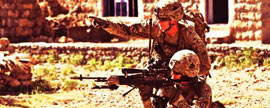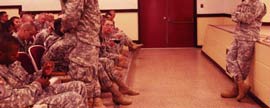The following is a brief discussion of how to prepare for a Change of Command Inventory but it could easily apply to any Leader change of hand receipt.
Preparing for the Inventory
Before beginning the inventory, sit down with the unit’s Property Book Officer (PBO). There are a few “take-aways” you should get from the Change of Command Brief:
- The amount of time you have to complete the inventory. PBOs will typically tell you that you’re allowed 30 days, with two extensions available on request.
- You should identify excess items for turn-in and Found-On-Installation items that are physically on hand but unaccounted for.
- Get the list of required documents to complete the handover. This may include the list of items that don’t have TMs, assumption of command orders, joint inventory statements, an after action report, etc. Be sure to get examples of what these look like.
- The PBO’s phone number, in case something is not right, i.e. missing property, wrong serial numbers on sensitive items, or necessary personnel are not available (like the supply sergeant or the sub-hand receipt holders).
- The cyclic inventory schedule (by month, quarter, etc.)
- The Primary Hand Receipt, in two formats: Cyclic, and organized by Property Book Identification Code (PBIC)
- Copies of all sub-hand receipts.
- A divestiture report so you can identify what items may be obsolete.
With these items in hand, you should now mark your UAVR and sub-hand receipts to note the following:
- Which items have subsystems, so you know when to refer to your Subsystems List.
- How much BII each item has:
- No TM
- A TM, but no BII (some generators are like this)
- A little BII (like a generator with only a grounding rod)
- A lot of BII (like a P99881 CAISI antenna)
- A -10HR, for items like trucks that have preprinted 2062s in ETMs Online
- Sets, Kits, or Outfits (SKOs), like a T28688 General Mechanic Tool Kit.
3. Whether an item is required by MTOE or not.
4. Whether the unit is short or has an excess of any end items (and which hand receipt holder should be the one to turn theirs in).
5. Which month the equipment falls in for a cyclic inventory.
6. What items are obsolete, if any.
To blend the advantages of all these individual documents, carry around the following in a binder:
- The marked-up copy of the UAVR.
- The Subsystem List from the PBIC printout.
- The marked up copies of the sub-hand receipts.
- Several blank DA Form 2062s (or -10HRs, if possible), to document shortages.
As you look over the schedule and sub-hand receipts, you should get an idea how the inventory will be conducted. For each area, there are two approaches:
Method 1.
Take a medium truck company, for example. Since the platoons have essentially the same equipment, it makes sense for the whole company to lay out all M1083 Medium Tactical Vehicles (MTVs) with their associated BII at the same time. This way, you can properly identify all shortages and keep sub-hand receipt holders from sharing the same BII (ever seen the movie Sergeant Bilko?). This method works well with OE-254 antennas, M777 Howitzers, or anything else with numerous components distributed among multiple sub-hand receipt holders.
Method 2.
Computers, armory equipment, and CBRN equipment are items can be effectively inventoried by individual sub-hand receipt holders. Since computers have serial numbers, sub-hand receipt holders can’t trade them out. Other items, like weapon tripods, are held only by the armorer. Similarly, CBRN equipment is typically maintained by the unit CBRN specialist.
Summary
By understanding when to apply the two methods, you can identify “red flag” situations. If you find yourself looking at similar property from different hand receipt holders day after day, a red flag should go up in your head—why was this not all laid out at the same time? Is there an ongoing mission requirement, or was it simply poor planning? Are sub-hand receipt holders sharing BII? These kinds of observations should be reported to the PBO.
For More Information on this subject see the following resource(s):














